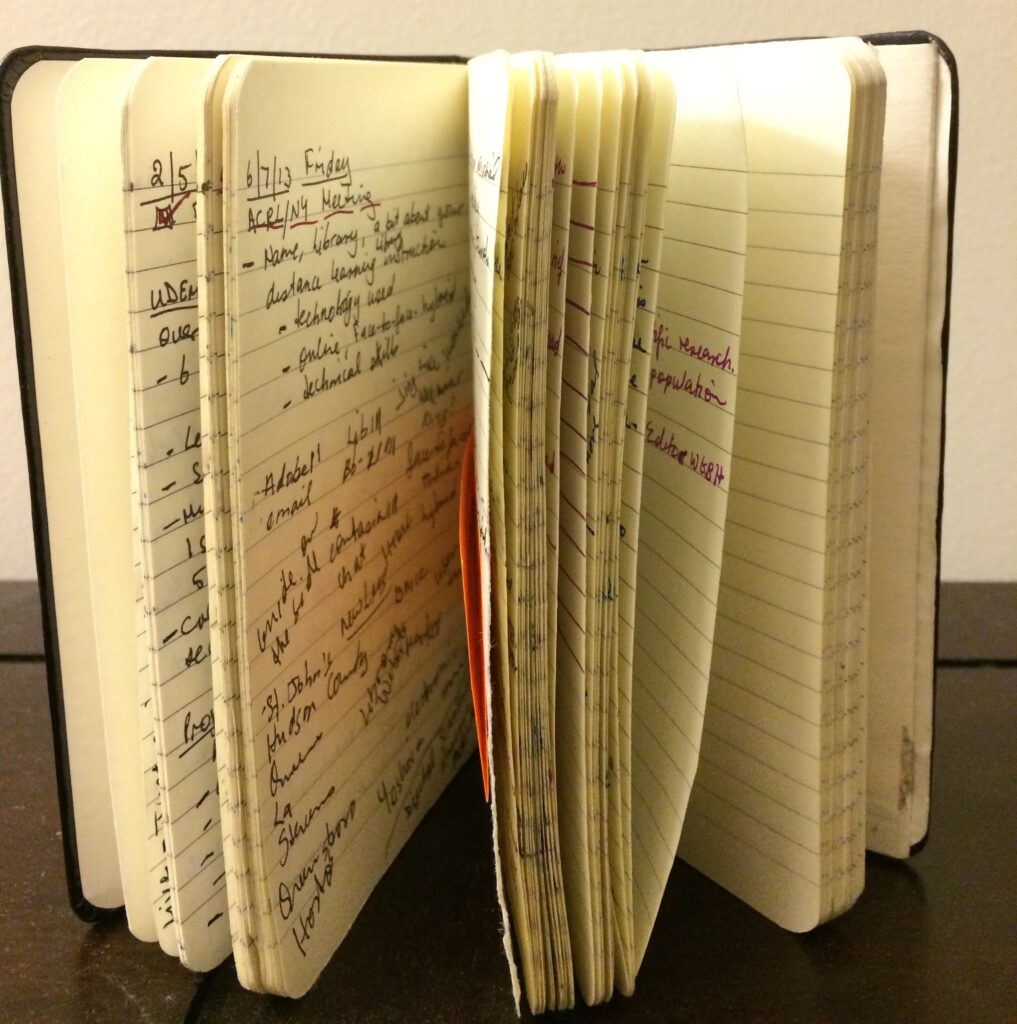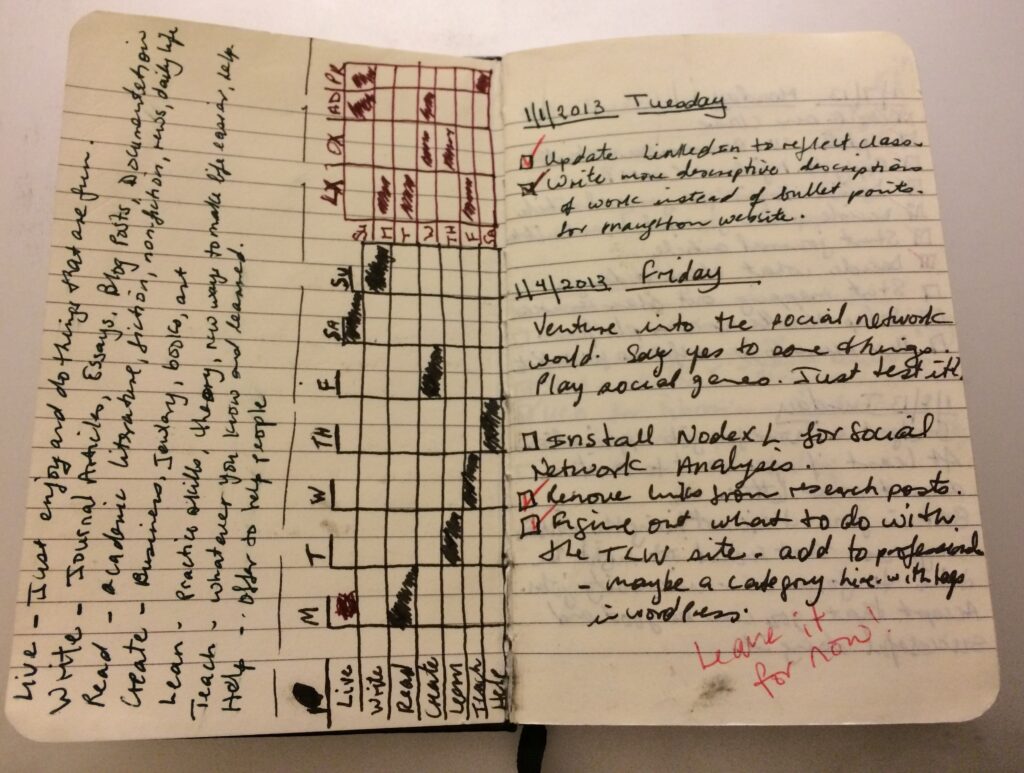Write it down!

Writing things down has always been my way to learn and to remember, and as such, I have developed habits that help to keep me productive and reflective. I write lists. I find lists to be exactly right for being productive and for keeping track of what I’ve done, what I’m currently doing, and what I’m planning to do next. Some of these lists turn into checklists, but they mostly record my thoughts and plans.
Get a Notebook
The notebook can be digital, but I find that the physical notebook has more affordances than the digital, for that reason, this post will focus on the traditional physical notebook.
The notebook should be something you like, something you can have with you frequently, and something small enough to carry, but big enough to hold your thoughts. Paired with the notebook is a great writing instrument: pen/pencil/maker. There’s a certain pleasure in finding a notebook with great paper and a pen that writes wonderfully on it. It will make the process of using the notebook more pleasurable, so spend the time to find exactly what suits you. You’re going to be using it a lot.
Determine the Purpose
I have multiple personal list notebooks, but they fall into two main categories:
- Personal Life – this notebook is focused on the things in my life that requires some tracking, planning and reflecting. It can have thoughts, ideas, observations, plans, etc.. It can be focused on any subject or nothing in particular. It is the notebook that I take with me anywhere and no one ever really sees what’s in it.
- Work – this notebook is very focused on specific work products. As a consultant and researcher, I work on multiple projects for multiple companies, which makes a company-based personal list notebook important for tracking and planning successful projects. It is the place where I explore ideas, work out details before sharing with others, document pieces of information before compiling, and reflect on possibilities.
In both cases, the notebooks are personal because they are not intended to be shared with others. Depending on the information housed in the notebook, some will move on to become another form of documentation to be shared with others, some will never leave the notebook and never become a checklist, but some will be checklists.
Write
There are a few things to keep in mind when you write in your notebook. It’s a notebook rather than a checklist because it’s not about the list. It’s about writing things down and moving information from inside the mind to the world outside the mind. The list will come later. Additionally, it is not about marking things off, even though it feels great. It’s about making choices and reflecting on those choices.
1. Audience: You.
The main goal is to document your thoughts in ways that you’ll understand. A list is a fast and effective way to make sure I understand my own thoughts later on. Very little rambling required.
2. What to Write: Anything
Start with your thoughts, ideas, plans, goals, observations, and projects. These are the most important elements of your notebook. If I think of something that I want to remember, I write a little note in my notebook. If I’m at work and there’s a meeting, I write notes in my notebook. They may not be coherent to anyone else, but at a minimum they need to be coherent to me.
3. How to Write: However you please Always start with today’s date. Document however you want. Write it down. Draw it. Diagram it. Photograph it. Give it some space on the page.
- If you’re a word person, then write it down in words.
- If you’re a visual person, then write it down in pictures.
- If you’re some combination of the two, then write it down in pictures and words.
4. Use Colors: Your choice
People use different colors for different purposes and can have very intricate meaning. If you’re that person, go for it. It’s a great tool and provides immediate visual clues to your list. I’m not that person, but I do like using multiple colors for two purposes:
- Red – I use red to check items off and write updates. So, when I flip through my notebook, I can see red checkmarks and notes on what happened with that task. This probably stems from being a teacher and grading in red ink. It has stuck with me and I rather enjoy it.
- All other colors – I use whatever color I feel like using in that moment to write things down. It doesn’t matter what the color is as long as it’s not red. This helps to keep my notebook interesting but doesn’t have an intricate color code that I need to remember. It’s not about the colors. It’s about getting the information down and out of my head.
5. Read and re-read: Always
Writing moves information from your mind into the world and as such it’s important to read and re-read what you’ve written. Repetition helps with learning so it is important that my thoughts are represented in a way I understand today and will tomorrow, even if that tomorrow is six months from now. It only needs to make sense to me, not to anyone else.
6. Take Action: Task or Descriptive Note
Once something has been written down, it is up to you to decide if it is a task, something you intend to do, or descriptive note, something you just want to document.
- Task: If it’s a task, then add a checkbox next to that item
- Descriptive note: If it’s a descriptive note, then leave it be. It will be good to read later.
This is where your checklist will suddenly appear. You don’t start with the checklist, but rather the checklist emerges as you read through your ideas and decide if there are things you should be doing. You then create the box that you will check next to an item you’ve decided is a task.
7. Timelines: If you’re into deadlines, you might go crazy, but I don’t recommend it. It’s not worth it. Not everything needs a deadline. Besides, it’s no fun having something called a “deadline” in your notebook. Nothing is dying. Things will be done, not dead.
Timelines can be helpful. They tell you:
- Time: How much time do you have to work on this task?
- Priority: Is this a higher priority because it is due sooner?
- Fit: Where does this task fit with all the other tasks I have to get done?
- Calendar: How does this task look on a calendar with other plans and activities?
- External Constraint: This project is due to “x” by “y,” which gives me “z” time to get it done
- Internal Constraint: I need to get this done by Friday, two days, so I can have rum raisin ice-cream.
The catch here is to make sure that creating a timeline and adding dates to tasks do not cripple you or stress you out. If it does, then you’ll need to adjust how you date items and what dates mean to you. For me, it is not about the dates. It is about the agreement I make with myself and others about getting things done. I only put a box next to items I intend to get done, not next to items I’m just thinking about. The date helps me to hold myself accountable, but they are not necessary. The checkbox is necessary.
8. Do Task or Not: No strike-through!
The more you write down your thoughts, the clearer you’ll become about what things you will actually do, what things you’ll leave for later, and what things you won’t do. That’s why the notebook is good. It allows you to see your own progress and what you still have intention of accomplishing. Checklists, generally do not provide you with enough reflection to connect your action to your overall goals and plans. So, here’s how you handle a checklist in your personal list notebook.
- Do task: If you do the task, put a checkmark in the checkbox. Do not strike through the task or scratch it off. You want to be able to read it again. You might change your mind later. Strikethroughs are generally banned in my notebooks unless I made a mistake, and even then, I try not to use them. A completed task is rewarded with a checkmark not a strikethrough.
- Intend to, but not yet: If you don’t do the task, but think you will at some point in the future, then leave it as is. The checkbox will still be there when you come back.
- Didn’t do it and don’t intend to: If you don’t do it and don’t intend to do it, then put a reason next to it with a date. Again, no strikethrough. An “x” in the checkbox can work. Adding a reason and a date comes in handy when you suddenly find yourself thinking the same thing months later and can’t remember why it didn’t happen. Just flip back and see why you decided not to do it. If you strikethrough, you may not be able to re-read it, which might make you create the same task again and repeat the process all over again.
9. Flip Frequently: See what you’ve done and what needs to be done.With the physical notebook, you can just flip through the pages quickly and see where there are empty checkboxes. Read through tasks still to be done and decide if you’re going to do those tasks.
- Yes, I’m going to do it: If you are at some point going to do that task, leave it be.
- No, I’m never going to do it: If not ever, put an “x”in the checkbox, the date and a note. The empty checkboxes are reminders but they don’t all need to be checked.
10. Reflect: Reflect on what you’ve done.
Since it’s a notebook, you can read your thoughts from yesterday or last month or last year, depending on your notebook capacity. You can see and feel proud of all the red checkmarks. You can even remind yourself about things you’ve already forgotten.
Traditional checklists have a place and can be very efficient for specific repetitive step-based activities. However, they are not always the best solution for daily productivity because of a strong focus on checking things off and getting rid of it to then start again tomorrow. Such checklists are inefficient and do not account for context or reflection.

A personal list notebook is about doing things and seeing what was done over time. As you might have noticed, there’s no place where you rewrite a task on a new day because yesterday has passed. Yesterday is still in your notebook and if you want to see what you still need to do, you can turn the page back. Nothing disappears. Everything remains. It is easy to see how much you accomplish over time by just keeping it all in a notebook. Besides, when you’re feeling bad about not accomplishing things, it’s a great reminder that you accomplish things all the time. People have short memories and the personal list notebook has a longer documented one that you can always access.
